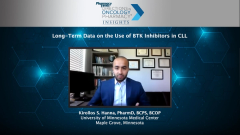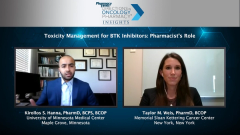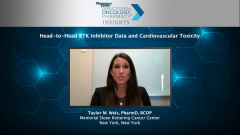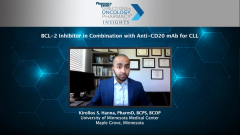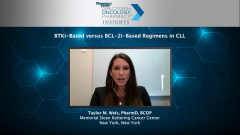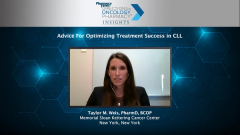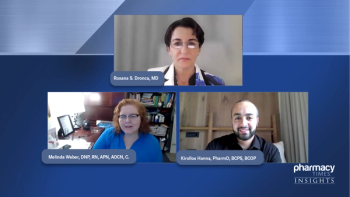
NCCN Guidelines: Rapid Change in CLL Treatment Concepts
Taylor M. Weis, PharmD, BCOP, discusses NCCN guidelines for first-line therapy as well as the rationale behind the rapid change in treatment concepts for CLL.
Episodes in this series

Kirollos S. Hanna, PharmD, BCPS, BCOP: Ultimately, Dr Weis, what are your recommendations or what are you seeing in clinical practice as first-line therapy for patients who are newly diagnosed with CLL [chronic lymphocytic leukemia] or SLL [small lymphocytic lymphoma]? I would love to hear what you guys are doing at Memorial Sloan Kettering Cancer Center when you’re selecting treatment for your patients up front. Are you going right away with BTK [Bruton tyrosine kinase inhibitors] regardless of deletion 17p, IGHV mutation status, patient comorbidities or frail status? Also, I would love to hear from you, what do the guidelines recommend? What does the NCCN [National Comprehensive Cancer Network] recommend for frontline management for patients? What kind of shifts have you been seeing over the years? Is it what I’ve alluded to from chemoimmunotherapy? I would love to hear some of that perspective.
Taylor M. Weis, PharmD, BCOP: Yes, thank you very much. I’ll start with what the NCCN recommends and then go into what I’m seeing happening in our clinics here at Memorial Sloan Kettering Cancer Center. The NCCN, based on recent updates, has made a drastic shift in just a few years as you have previously mentioned. Prior to the burst of novel agents in the frontline setting, the main question providers were asking themselves prior to starting therapy was, OK, we have a patient with CLL. They are a candidate for therapy; what is their fitness? Are they able to tolerate very intensive chemoimmunotherapy with FCR [fludarabine, cyclophosphamide, rituximab]? Or are they more of an older, frail patient who may need something lower intensity, such as a bendamustine- or chlorambucil-based regimen? Now, the questions are quite different. What we have seen is that these novel agents have had improved overall response rates in a lot of studies and improved progression-free survival, and in some cases, an overall survival benefit over these traditional chemoimmunotherapy-based approaches in almost all subtypes of patients. The NCCN [guidelines] reflect this. Even among patients with high-risk features and patients with low-risk features, all their preferred frontline regimens are one of the novel agent-based therapies, whether this is an ibrutinib monotherapy, acalabrutinib plus or minus an anti-CD20 antibody, venetoclax plus obinutuzumab, and these are all category 1 recommendations.
Chemoimmunotherapy has shifted into the other recommended regimens criteria. There is a rare case where chemoimmunotherapy may still be preferred for some patients, and the NCCN designates that. So, our young, fit patients who have immunoglobulin heavy chain variable, or IGHV, gene mutations still may have very impressive remissions and long remissions with FCR [fludarabine, cyclophosphamide, rituximab]-based approaches, and therefore, they may still be preferred in this specific patient population. However, the fact is CLL is a disease of the elderly. The vast majority of our patient population is older patients with more comorbidities, and what I am seeing in the clinic is that they are benefiting from these more tolerable oral regimens that they can take at home. For the most part, we are going with these novel agent therapies in the frontline setting for the vast majority of our patient population, with the caveats of maybe younger patients with IGHV gene mutations that may benefit from FCR [fludarabine, cyclophosphamide, rituximab] still. It’s always a discussion with the patient when it comes to that scenario as well.
Kirollos S. Hanna, PharmD, BCPS, BCOP: Please continue.
Taylor M. Weis, PharmD, BCOP: One of the subsets that I think has had the best benefit from this change is our high-risk patients, specifically with deletion 11q, IGHV unmutated patients. Patients with deletion 17p or TP53 mutations. These were traditionally patients who were basically resistant to chemoimmunotherapy. We would still often give them chemoimmunotherapy-based approaches, but they often had a lot of toxicities and not much benefit from treatment. Now they’re having responses and remissions that seem very durable with long-term follow-up.
Kirollos S. Hanna, PharmD, BCPS, BCOP: Excellent. I appreciate you saying a lot of these things because one thing I have to constantly remind myself is, yes, although we have these novel therapies now, BTK targeting, BCL2 in combination with anti-CD20, I always have to remind myself of the NCCN guidelines. For those select patients who may have IGHV mutated status, it’s kind of like what we talk about in oncology. When we talk about mutation, generally it’s a bad thing. But in CLL, it’s something that isn’t too bad, although we can still potentially use chemoimmunotherapy as you said and have very good remission or responses.
Transcript edited for clarity.
Newsletter
Stay informed on drug updates, treatment guidelines, and pharmacy practice trends—subscribe to Pharmacy Times for weekly clinical insights.



